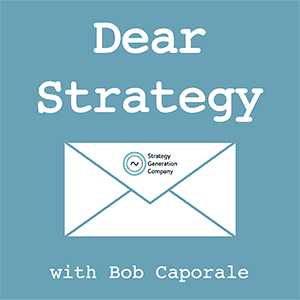Dear Strategy:
“In a rapidly changing marketplace, how should teams balance the need to support the core business and the need to tackle innovation? What tactical steps can allow an organization to succeed at both without segregating people into separate teams?”
In the last episode, I addressed a question about how a company can maintain some level of balance between approaching a new future while still respecting its own successful past. This week’s question, for all intents and purposes, picks up where that one left off. In other words, once a company accepts that some level of balance will be needed between the old and the new, how should it go about successfully implementing that strategy in the marketplace?
The first interesting thing to note about the way this week’s question is framed is that there seems to be some pre-disposed bias against the idea of having separate teams to handle the core business vs. the true innovative part of the business.
Personally, I wouldn’t rule this approach out so quickly.
In fact, it is very common for companies (especially large ones) to have separate teams that are solely tasked with identifying and researching breakthrough technologies and ideas that could ultimately be applied into the core business. The premise here is that these teams can remain unencumbered by any issues or limitations associated with the day-to-day business and, instead, stay completely focused on thinking outside of a box that may not have yet been defined. Of course, the downside of taking this approach is that it requires a significant amount of resources. However, the upside is that these teams will typically act as mini-incubators; giving their respective companies all the cultural advantages of smaller startup businesses, while still maintaining the higher level of financial access that larger companies typically enjoy.
Of course, if you do decide to have a team like this, you have to ensure that it maintains a clear connection back to the core business for the purpose of deciding which ideas should ultimately be commercialized and which ones would be better off remaining on the cutting room floor. Without this checkpoint, companies are likely to invest in the ideas that they think will be successful, rather than the ideas that their customers truly want to buy. This is the part of the equation that is going to provide that “balance” that is being asked about here; ensuring that the authority for making the final investment decision lies in the hands of the person who is ultimately responsible for managing the overall business lifecycle.
Now, as to the question of exactly what that balance should look like – that is going to vary based on the type of growth strategy each company decides to pursue.
Often times, companies will outline, from the top down, how much of their sales they want to come from breakthrough vs. existing product technologies. This isn’t to be confused with what is often referred to as a “Vitality Index,” which is defined as a company’s revenue from “new products” stated as a percentage of its overall sales. I put the term “new products” in quotes here because, for the purposes of a Vitality Index, companies will typically define their new product sales in terms of any new SKUs that were released within the last 5 years (or some similar timeframe). Now, in my humble opinion, there are actually many things wrong with this measurement, and I’ll save that particular rant for another post. But, for the purposes of this discussion, let’s just say that most new SKUs don’t come anywhere near qualifying as breakthrough technologies. So, all of that to say, if you’re trying to measure how innovative your company truly is, the Vitality Index is not necessarily the best metric for that purpose.
“Let’s just say that most new SKUs don’t come anywhere near qualifying as breakthrough technologies.”
Rather than tracking new SKUs, companies, instead, should consider measuring their pipeline of new product ideas and tracking how many of those ideas are arising from truly breakthrough technologies. The idea here is that this number will translate into some percentage of a company’s revenue and profit in any given year eventually coming from those breakthrough technologies as well. Of course, there are still some complexities associated with this that will need to be worked out. For example, what is the definition of a breakthrough technology, and how long should that technology be defined as being a breakthrough? Unlike the Vitality Index, which takes a singular timeframe and spreads it across all new products indiscriminately, timeframes for breakthrough technologies will need to be determined on an individual case-by-case basis – taking into consideration such things as patent protection, competitive responses, and even customer perceptions.
And even with all of that, you have to remember that being an innovative company will not necessarily equate to being a successful company. In other words, you can have 100% of your sales coming from breakthrough technologies and still be bankrupt! Which brings us full circle as to why maintaining that unbreakable connection between the innovation teams and the core business teams is so incredibly important.
So, with all of that said, here’s what my answer boils down to:
- Have a goal as to how much of your pipeline you want coming from breakthrough technologies.
- Have a separate innovation team that is solely tasked with identifying and exploring those new technologies.
- Make sure that the core business team has the final say as to which new technologies will ultimately be commercialized, lest you run the risk of those technologies not producing enough revenue and/or profit to support their own development in the first place.
And if you get all of that right, you might just be the next big company to truly change the world before someone far smaller and far less capable beats you to it.
Listen to the podcast episode
Dear Strategy: Episode 090

###
Are you interested in strategy workshops for your product, marketing, or business managers? If so, please be sure to visit Strategy Generation Company by clicking the link below:
 Bob Caporale is the founder of Strategy Generation Company, the author of Creative Strategy Generation and the host of the Dear Strategy podcast. You can learn more about his work by visiting bobcaporale.com.
Bob Caporale is the founder of Strategy Generation Company, the author of Creative Strategy Generation and the host of the Dear Strategy podcast. You can learn more about his work by visiting bobcaporale.com.







